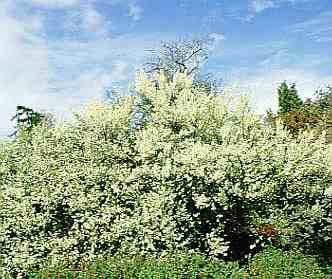Cytisus multiflorus
white Spanish broom
An erect, medium-sized deciduous shrub with slender, greyish shoots bearing small creamy-white flowers in great profusion in late spring and early summer
Size
Ultimate height
1.5–2.5 metresTime to ultimate height
2–5 yearsUltimate spread
1.5–2.5 metresGrowing conditions
Moisture
Well–drainedpH
Acid, Alkaline, NeutralColour & scent
| Stem | Flower | Foliage | Fruit | |
| Spring | White | Green | ||
|---|---|---|---|---|
| Summer | White | Green | ||
| Autumn | Green | |||
| Winter |
Position
- Full sun
Aspect
South–facing or West–facing
Exposure
Exposed or ShelteredDrought resistance
Yes Hardiness
H5Botanical details
- Family
- Fabaceae
- Native to GB / Ireland
- No
- Foliage
- Deciduous
- Habit
- Bushy
- Potentially harmful
- Humans/Pets (dogs): Harmful if eaten. Wear gloves and other protective equipment when handling. For further information and contact numbers regarding pets, see the HTA guide to potentially harmful plants
- Genus
Cytisus can be deciduous or evergreen shrubs, ranging from prostrate to erect and almost tree-like, with small, simple or 3-parted leaves and pea-like flowers spring or summer
- Name status
Correct
How to grow
Cultivation
Grow in moderately fertile, well-drained, preferably acid soil in full sun. Suitable for rock garden or raised bed. Resents transplanting and may become chlorotic on particularly shallow, chalky soils
Propagation
Propagate by seed sown in containers in a cold frame in spring or autumn or semi-hardwood cuttings in late summer
Suggested planting locations and garden types
- Cottage and informal garden
- Coastal
- Gravel garden
- Flower borders and beds
Pruning
Pruning group 1 or pruning group 3. Do not cut into old wood
Pests
May be susceptible to broom gall mites
Diseases
May be susceptible to honey fungus
Love gardening
Sign up to receive regular gardening tips, inspiration, offers and more
View our Privacy Policy
Get involved
The Royal Horticultural Society is the UK’s leading gardening charity. We aim to enrich everyone’s life through plants, and make the UK a greener and more beautiful place.
